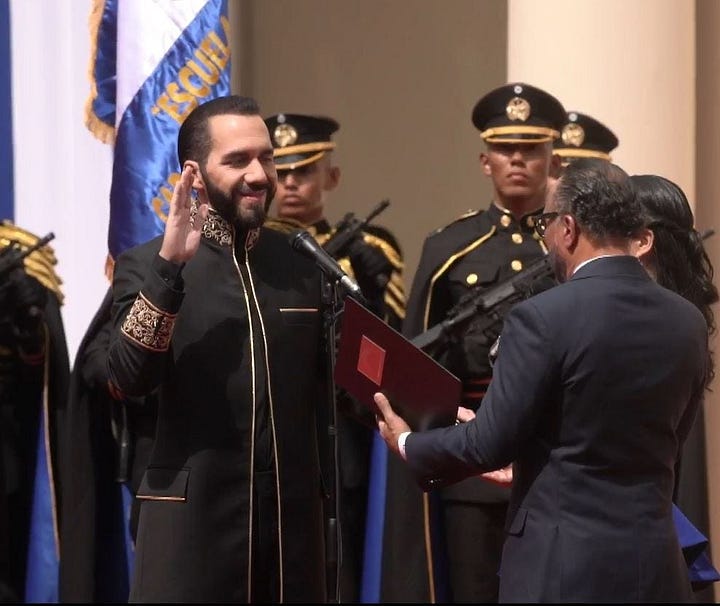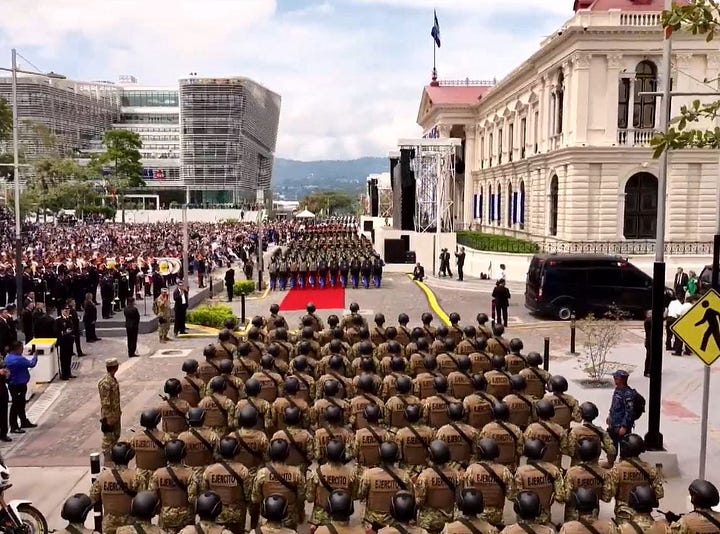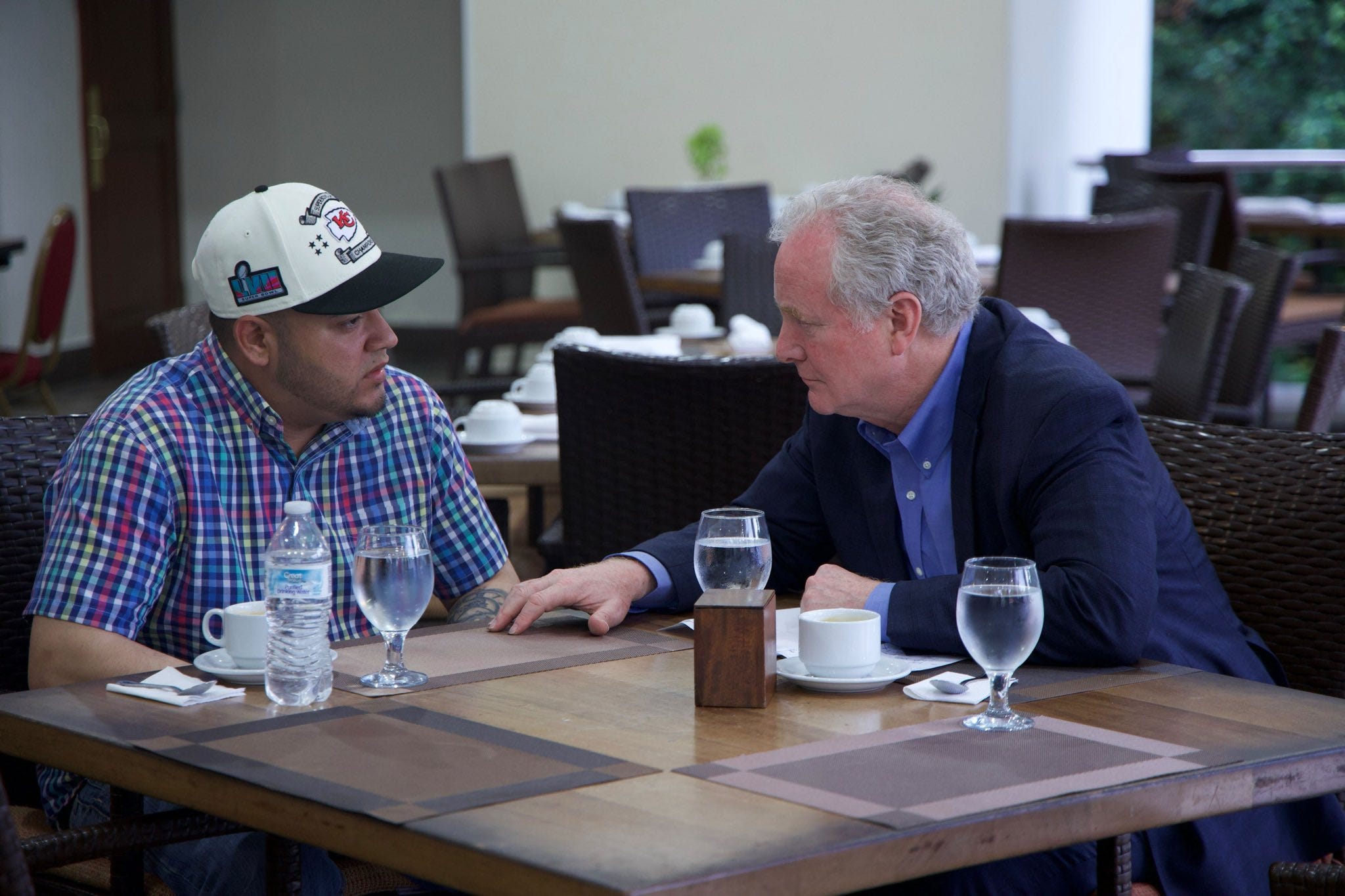How the Salvadoran photo-op illustrates Bukele's ruling style
The self-proclaimed 'coolest dictator in the world' rose to power in part on careful stage-managing and cultivation of a laser-focused brand
This is our “LATAM Wires” daily newsletter, freshly launched. Signing up will get you flash updates on breaking stories and snapshots of development on big headlines. And it’s free! We chose not to automatically enroll the thousands of subscribers from our PWS features newsletter, so if you’re already reading us there, and this interests you, sign up!
Maryland Sen. Chris Van Hollen finally met with Kilmar Abrego Garcia on April 17 in El Salvador, achieving a face-to-face meeting with the man wrongfully deported from Van Hollen’s state.
The Democratic senator posted a photo of the meeting on X but Garcia’s future remains unclear. Both the White House and Salvadoran President Nayib Bukele quickly released comments that he will not be returned to the United States.
The photo, and the additional images subsequently released by the Salvadoran government, illustrate key points about Bukele’s ruling style, which has always been as manicured and carefully maintained as his signature tight-cropped beard.
Within one minute of Van Hollen’s statement, Bukele posted additional photos of the meeting, along with a statement claiming that Garcia was “miraculously risen from the ‘death camps’…now sipping margaritas with Sen. Van Hollen in the tropical paradise of El Salvador!”


In both sets of photos, Garcia appears in clean civilian clothes rather than a prison uniform from the Terrorism Confinement Center (CECOT) where he is held. He wears a hat, presumably given to him to hide his buzzcut head, and is relatively recently shaven.
He was given a short-sleeved shirt, so that his tattoos would be visible to the cameras, and casual blue jeans. It is all clearly intended to project an image of prison officials treating him humanely, despite the international concerns over conditions at the infamous CECOT prison.
But it is also designed to undermine the credibility of everyone involved, including Van Hollen. The tattoos are only the beginning.
An aide to Van Hollen anonymously claimed to U.S. media that the two glasses with sugar rims and a maraschino cherry were placed at the table mid-meeting to stage a photo-op.
The claim has inspired mockery on social media that such a transparent ploy would even be attempted. But those who find the attempt clumsy or clownish are missing a crucial point: it doesn’t matter whether Bukele’s supporters believe it or not.
The theatre, the trolling, and the cruel spectacle of it all are the point, and the strategy.
Some of his fans will choose to believe Bukele’s claim. Others will take it as sarcastic clowning on two perceived opponents he doesn’t respect. Most simply won’t care.
To understand the dynamic, readers need only look to the responses from his fans on his social media accounts, particularly those posting from El Salvador, where in January he achieved a 91% approval rating.
From their perspective, when he makes false claims, he is clearly joking. Sometimes he is. His not-uncommon Twitter battles with iconic leftist presidents in Latin America, such as Gustavo Petro from Colombia, always employ a signature sarcasm and exaggeration for comic effect.
Other times his carefully chosen words and the imagery that accompany them are deadly serious.
On March 16, when the first flight of Venezuelan and Salvadoran deportees arrived to El Salvador — the same flight which contained Mr. Garcia — Bukele had hundreds of police and military waiting for them in tight military formation.
He also had a professional-quality film crew equipped with drones and multiple camera operators, all filming from carefully chosen angles, and editors on standby, ready to speed-cut a slick promotional video that was released just hours after their arrival.
The post accompanying the video made a series of false claims, including that all detainees were members of the Venezuelan ‘supergang’ the Tren de Aragua (a claim the Trump administration itself has walked back), and “notorious ringleaders of MS-13” (Presumably Garcia is included in the latter group, though a federal judge in the U.S. has rejected those claims).
The video — replete with a tough-guy scary soundtrack— illustrates Bukele’s obsession with pageantry. Prisoners are dehumanized by security forces presented as invincibly dominating. They are handled roughly, brusquely and humiliated before being locked away.
This is the message Bukele hammers home day after day, both domestically and internationally. He is imposing the law. He presents himself as the tough leader ‘willing to make the hard decisions to protect your children.’
A new sheriff is in town, and if he breaks some rules along the way to lock up the bad guys, well, they deserve it. And he even drops sarcastic one-liners as he does it. At heart, however, unlike a free-wheeling cowboy, he is disciplined and always on mission.
We’re not sure if you ever saw the photos from his unconstitutional second inauguration ceremony. But they illustrate the point rather succinctly.







